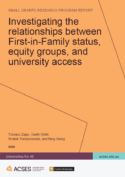This is the final report submitted for the ACSES Small Grants Research Program project “Investigating the relationships between First-in-Family status, equity groups, and university access”.
Lead researcher: Tomasz Zając, The University of Queensland (UQ)
Co-authors: Garth Stahl (UQ), Wojtek Tomaszewski (UQ), and Ning Xiang (UQ)
Read below for the key points of the report “at a glance”. The full report is available for download in PDF [3MB] or Word [3MB] format.
At a glance
What we did
The study involved analysis of data on two cohorts of young people from the Person Level Integrated Data Asset (PLIDA), a dataset linking administrative records from multiple public agencies, to compare the university enrolment patterns of First-in-Family (FiF) students, defined as students without university-educated parents, with that of non-FiF students. Data on individuals aged 16 or 17 years at the time of the 2016 Census, who lived with at least one parent, were used to capture their social background, including parental education. Using immigration records, the sample was narrowed to Australian citizens and permanent residents. Higher education records were then used to track their university enrolment status until 2019. The final analytic dataset comprised 443,609 individuals.
What we found
- FiF students constitute over two-thirds of the student population but have not been recognised as an official equity group in Australian higher education equity policy.
- FiF students have substantially lower rates of enrolment in university education than non-FiF students, by around 23 percentage points. The enrolment gap was larger than that observed for most of the official equity groups, with only students with disabilities observed to have a larger enrolment gap.
- Beyond access issues, FiF students also face additional disadvantage in enrolment at selective universities (defined as those with higher entry requirements). Over half of non-FiF students attended selective universities, as compared to only 39% of FiF students.
- There were also differences in the field of enrolment by FiF status, with FiF students more likely to enrol in education or health (excluding medicine) fields, and less likely to enrol in natural and physical sciences, engineering and related technologies, and medical studies.
What we recommend
- The Australian Government and stakeholders should consider First-in-Family (FiF) status (or parental education) as another important factor affecting university enrolments, access to first-tier institutions, and certain fields of study.
- The Australian Government and stakeholders should work together to build a data asset covering the full educational paths that would allow investigation of when and how the educational pathways of FiF individuals and their peers diverge.
- The Australian Government should consider funding further research exploring why attitudes and aspirations of FiF young people differ from those of non-FiF youth and how they shape educational outcomes. This is needed to better understand the mechanisms leading to the divergence of educational pathways.
- The Australian Government and stakeholders should invest in approaches to assist FiF individuals in gaining access to higher education, selective institutions, and fields in which they are underrepresented. They should also expand outreach and career counselling programs to equip FiF individuals with the knowledge necessary to navigate the higher education system as well as help them understand various career paths.
The full report is available for download in PDF [3MB] or Word [3MB] format.



